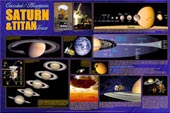


|

|
|
|
Cassini observations show dynamic dance at Saturn UNIVERSITY OF COLORADO-BOULDER NEWS RELEASE Posted: November 8, 2004 A University of Colorado at Boulder professor involved with the Cassini-Huygens mission is reporting an ever-changing vista at the frontiers of Saturn, featuring wayward moons, colliding meteoroids, rippling rings and flickering auroras. Larry Esposito of the Laboratory for Atmospheric and Space Physics said CU-Boulder's Ultraviolet Imaging Spectrometer, or UVIS, riding on Cassini is revealing a dynamic dance in the Saturn system. "Instead of a quiet panorama, UVIS sees rapidly changing phenomena, including interactions between the rings, moons, radiation belt, solar wind and the planet Saturn," said Esposito, the principal investigator for the $12.5 million UVIS instrument. The instrument has detected oxygen atoms in an immense cloud surrounding Saturn, the result of moonlets in the ring system colliding, shattering and releasing ice particles. The ice grains are bathed by Saturn's radiation belt, liberating the oxygen atoms that reflect sunlight and which makes them visible to the ultraviolet spectrometer, said Esposito. A UVIS analysis of Phoebe -- a tiny, dark moon about one-fifteenth the diameter of Earth's moon -- confirms the suspicions of many space scientists that it was born elsewhere, likely in the Kuiper Belt. The Kuiper Belt is a region beyond Neptune believed to populated with thousands of small, icy moons created during the formation of the solar system more than four billion years ago. "UVIS sees the absorption signature of water ice on its surface, showing Phoebe was born in the outer solar system," Esposito said. Exhibiting an unusual retrograde, or backward, orbit, Phoebe likely was lassoed by Saturn's powerful gravitational field during the planet's formative years, he said. Esposito presented his findings at the 36th annual Division of Planetary Sciences Meeting held in Louisville, Ken. Nov. 8 to Nov 12. The UVIS research team also has noted significant brightening of the auroras at Saturn's poles as the solar wind periodically ramps up to speeds of 250 miles, or 400 kilometers, per second, Esposito said. "Dense puffs of the charged particles from the sun excite the hydrogen molecules in Saturn's upper atmosphere to glow more brightly." In addition, UVIS continues to zero in on the fabulous ring system. "At the time Cassini went into orbit around Saturn, UVIS produced the highest detail images of Saturn's rings ever made in UV light," he said. "These images show the amount of water-ice varies in the ring particles' surfaces." The variation is caused by the contamination of the rings with meteoric dust, and by the subsequent transfer of material between the ring particles from collisions and meteoroid bombardment, Esposito said. "The fluctuations we see can be explained by the recent destruction of small moons within the rings, and by wave action in the rings that dredges fresh material onto the surfaces of the ring particles," Esposito said. "This indicates that the material in the rings is continually recycled from rings to moons and back." The UVIS instrument was used to obtain the highest resolution observations of the ring particles ever by focusing on the fluctuations of light from a distant star as it passed behind the rings, he said. The team also detected a density wave - a ripple-like feature in the rings caused by the influence of Saturn's moons -- - in the so-called Cassini Division. The Cassini Division is the gap between the bright A and B rings of Saturn that are visible from Earth using backyard telescopes, he said. "Analysis of such waves determines the size, mass and velocity of the ring particles," said Esposito. The UVIS instrument also is showing a bright glow in the upper atmosphere of Titan, the most intriguing of Saturn's 33 known moons and which will be targeted by the Cassini-Huygens probe slated for release by the spacecraft Christmas Eve. "Observations of Titan show the glow of nitrogen atoms, molecules and ions energized by electrons striking the upper atmosphere," he said. Launched in 1997, the Cassini-Huygens spacecraft achieved Saturn orbit June 30. During the spacecraft's four-year tour of the Saturn system, the UVIS team will continue to track the dynamic interactions of the planet's rings, moons and radiation belts, Esposito said. The Cassini-Huygens mission is a cooperative project of NASA, the European Space Agency and the Italian Space Agency. The Jet Propulsion Laboratory, a division of the California Institute of Technology in Pasadena, manages the Cassini-Huygens mission for NASA's Science Mission Directorate, Washington, D.C. |
|
|
|
Cassini poster Just in time for the Cassini spacecraft's arrival at Saturn, this new poster celebrates the mission to explore the ringed planet and its moons. Just in time for the Cassini spacecraft's arrival at Saturn, this new poster celebrates the mission to explore the ringed planet and its moons.2005 Calendar  The 2005 edition of the Universe of the Hubble Space Telescope calendar is available from our U.S. store and will soon be available worldwide. This 12x12-inch calendar features spectacular images from the orbiting observatory. The 2005 edition of the Universe of the Hubble Space Telescope calendar is available from our U.S. store and will soon be available worldwide. This 12x12-inch calendar features spectacular images from the orbiting observatory.Moon panorama  Taken by Apollo 14 commander Alan Shepard, this panoramic poster shows lunar module pilot Edgar Mitchell as a brilliant Sun glare reflects off the lunar module Antares. Taken by Apollo 14 commander Alan Shepard, this panoramic poster shows lunar module pilot Edgar Mitchell as a brilliant Sun glare reflects off the lunar module Antares.Mars Rover mission patch  A mission patch featuring NASA's Mars Exploration Rover is now available from the Astronomy Now Store. A mission patch featuring NASA's Mars Exploration Rover is now available from the Astronomy Now Store. |
||||||||||||||||||||